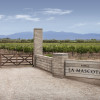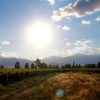The forests of Ñires and Lengas climb the slopes of the mountains, practically touching the snow. In the heart of the Río Azul valley, the calm and persistent flow of the river, which explains at first glance its name, advances towards one of the most attractive water mirrors of the Argentine South, Lake Puelo. To the trained eye, these wine lands don’t look at all like a viticultural landscape. However, the eye can be deceived: there, between the unknown Radal hill and the famous Piltriquitrón, spread out, are small plots of vineyards of one, two and up to eleven hectares. Almost all Pinot Noir, Chardonnay and Sauvignon Blanc, with some Merlot and Gewürztraminer.
It is well known that just a decade ago there was a promising vineyard in El Hoyo de Epuyén. Planted in the late 1990s, Patagonia Wines was at the same time the dream of winemaker Bernardo Weinert and a reminder that in Argentina little was known about the southern limit of winemaking. Now, between El Hoyo, Puelo, Bolsón, Paso del Sapo, Gualjaina, Trevelin and Capitán Sarmiento, the wine frontier expands beyond the 42º parallel to 45.5º, with small vineyards, many of them experimental, such as Viña Nant and Fall and Chacra la Primavera en la Cordillera, or those led by the brand new winegrower Sergio Mammarelli in Los Altares, or those of Tertulia de Gualjaina on the steppe.
Both in the southwest of Río Negro and in Chubut, there has been an incipient movement of wine lovers developing new plantations since 2011. Behind almost all of them, there is an agronomist in love with wine: Darío González Maldonado, alma mater of the region says, “I am convinced, and we have shown, that in this part of the world we can make sparkling wines on another level, especially with Pinot Noir and Chardonnay,” he explains at his house in El Hoyo.
For seventeen years he has been responsible for producing wines for Patagonian Wines and has accumulated so much experience in the area that in 2016, he became the technical director of the 75 hectare venture in Capitán Sarmiento, the largest in Chubut. A project by businessman Alejandro Bulgheroni will begin in 2018, which will be the southernmost winery in the world.
Southern constellation
At the end of November, what could be called the first integral tasting of Chubut wines was presented in Buenos Aires. Several producers participated, among those who stood out were Familia de Bernardi Sauvignon Blanc and Cien Lunas Pinot Noir. To them, we must add the wine that Paz Levinson, the best sommelier of Argentina, bottled with grapes from Paso del Sapo in 2013.
But if these products have little impact – the biggest production being around six thousand bottles per year – and are difficult to find, what makes this new frontier interesting is the promise it holds.
On one hand, the exploration of cold, sunny areas on the steppe or humid and cold in the Cordillera, at low altitude. On the other, the contribution of freshness that they give to Argentine wine. “I think,” says Maldonado, “that on the steppe we can produce a type of red mature in aromas and rich in freshness or sweet whites with a tense palate. In the Cordillera, however, wines are crisp and fresh, especially the whites. “
For a palate accustomed to the high altitude wines of the desert, the profile described by the agronomist is at the very least surprising. It is close to those obtained at 1,500m in Mendoza, with lower levels of phenolic maturity and sugar.
Alejandro Cánovas, the oenologist in charge of elaborating the first grapes of Capitán Sarmiento while still in the stage of experimentation, nevertheless believes that “the distance, the isolation and the lack of suppliers can, given time, make the perfect wine. Everything indicates that it is worth trying. “
Secrets of the South
Patagonia, until just recently, comprised Rio Negro, Neuquén and La Pampa in terms of wine growing. While these three provinces cover 3,500 hectares of vineyards, the emergence of Chubut, which hasn’t yet reached 100 ha, is experimental.
This new area also presents some challenges. The first is that being away from the epicentres means higher costs. The second is that, in many cases, they are hitting the limit of their production, with mountainous areas, where late or early frost are frequent. These difficulties explain, at least in part, the scale of these projects, which generally cover between one and five experimental hectares.
However, the emergence of a dozen of them sets a new standard for the region. They have tourism in their favor with many fishing lodges and game reserves nearby in which to offer their wines. The best example is offered by Estancia Los Robles: with its own lodge, they even have a harvest party for visitors, who also harvest and elaborate the three hectares of vineyards from the Rincón de los Leones brand.
“Everything is developing and advancing,” says Maldonado, who has watched the Chubut vineyard grow from scratch. A challenge to find on the market, the best way to discover the wines of Southern Patagonia is to take a trip there. In that sense, no one can regret crossing canyons and forests, vast, barren steppes, and fishing in calm, blue rivers like the skies of Patagonia itself, all to drink a good glass of wine.




Te accords de “Faldeo de Epuyén” de Weinert? Era hermoso
que lindo articulo. mucho talento en Javier Maldonado. Nos enriquece con su sabiduria. Gracias por estar cerca nuestro.